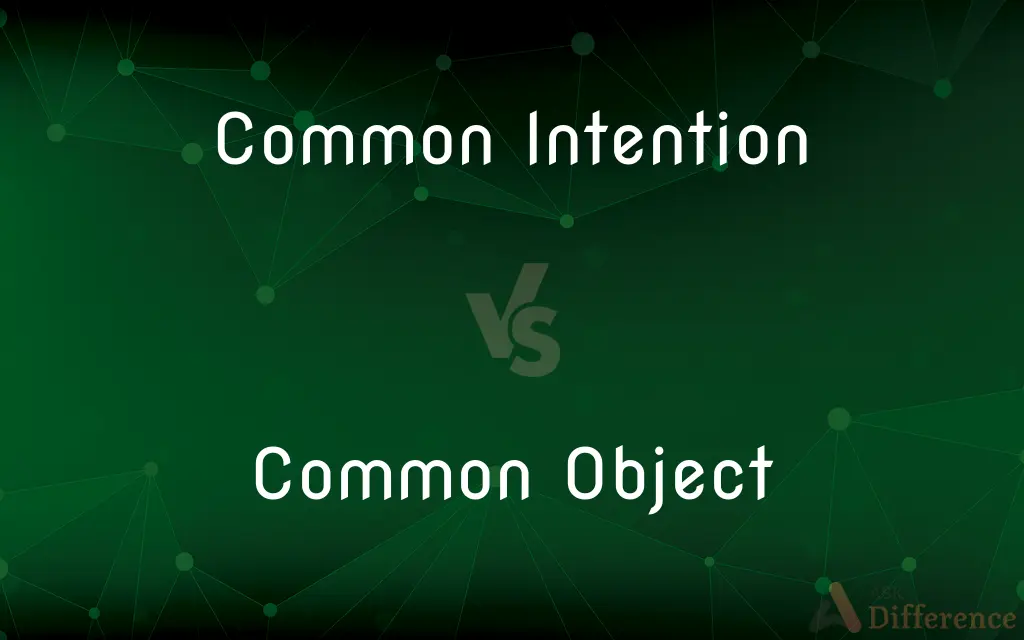Common Intention vs. Common Object — What's the Difference?
By Tayyaba Rehman — Published on October 20, 2023
Common Intention implies a shared plan or purpose between people. Common Object refers to a mutual goal or item of focus without implying a pre-planned agreement.

Difference Between Common Intention and Common Object
Table of Contents
ADVERTISEMENT
Key Differences
In analyzing "Common Intention", it is perceptible that it connotes a unified purpose or agreement among individuals. People with a common intention deliberately plan and agree upon a particular course of action. They hold a concerted desire or motive, which often directs their actions toward a specific outcome. In contrast, “Common Object” does not necessarily embody a planned or agreed-upon motive among individuals.
“Common Object”, conversely, entails a shared goal or target but lacks the deliberation that characterizes common intention. This term implies that individuals collectively focus or act towards a particular item or goal, without suggesting a unified, pre-conceived plan or agreement among them. Meanwhile, individuals with a common intention would not only share a goal but actively coordinate and strategize to achieve it.
With "Common Intention", there is a clarity and determination among all participants to attain a specific goal. This means every member equally understands and agrees upon the intended outcome and the path to achieve it. Contrarily, when discussing “Common Object”, it isn’t required for all individuals to have an identical understanding or agreement on the method of achieving the object.
"Common Object" signifies the joint focus of people on a particular goal or item. This term illustrates a scenario where the focus of individuals converges on a single objective without necessarily being stemmed from a collective decision or planned strategy. Whereas in scenarios featuring a “Common Intention”, the collaborative planning and decision-making process plays a crucial role.
Comparison Chart
Implies Planning
Yes, involves deliberate planning and agreement.
No, does not imply pre-planned agreement.
ADVERTISEMENT
Focus
On mutual planning and agreement.
On a mutual goal or item without unified planning.
Actors
Must be aware and agreed on intention.
May not be aware or agreed on methods.
Usage in Sentence
Denotes collective purpose and strategy.
Denotes collective focus without strategy.
Legal Aspect
Implies conspiratorial or agreed upon act.
Does not imply conspiracy or planned act.
Compare with Definitions
Common Intention
Joint Purpose
Their common intention was to raise funds for charity.
Common Object
Unified Aim
Achieving peace was their common object.
Common Intention
Concerted Effort
The common intention was to enhance community welfare.
Common Object
Mutual Desire
The villagers had a common object to build a new well.
Common Intention
Shared Resolve
Their common intention to safeguard the environment was evident.
Common Object
Shared Focus
The common object was to reach the mountaintop.
Common Intention
Unified Plan
They acted with a common intention to renovate the park.
Common Object
Joint Goal
Winning the match became the common object for the team.
Common Intention
Collective Agreement
The team had a common intention to win the championship.
Common Object
Collective Target
The common object was accumulating $10,000 for the fundraiser.
Common Curiosities
Can a Common Object evolve without planning?
Yes, it doesn’t necessarily involve premeditation or planning.
What defines a Common Intention?
A unified, pre-agreed plan or purpose shared among individuals.
Is prior planning necessary for Common Intention?
Yes, it involves premeditated agreement and planning.
Is Common Object always non-conspiratorial?
Generally, yes, as it lacks the intentional planning that suggests conspiracy.
Can a group have a Common Object without communication?
Yes, as it doesn’t necessitate coordinated planning or agreement.
Must all parties be aware of the plan in a Common Intention?
Yes, all parties should be consciously aligned with the plan.
Is unanimity in strategy required in Common Object?
No, individuals might not have a unified strategy or plan.
What is meant by Common Object?
A shared goal or focus among individuals without implying a pre-planned agreement.
Can individuals accidentally have a Common Object?
Yes, since it doesn’t require prior agreement or deliberate planning.
Can Common Object imply a legal responsibility?
Not usually, since it doesn’t imply a coordinated or conspiratorial effort.
Can a Common Object transform into a Common Intention?
Potentially, if the shared focus develops into a unified, planned effort.
Share Your Discovery

Previous Comparison
Black Tie vs. White Tie
Next Comparison
Quick vs. SnappyAuthor Spotlight
Written by
Tayyaba RehmanTayyaba Rehman is a distinguished writer, currently serving as a primary contributor to askdifference.com. As a researcher in semantics and etymology, Tayyaba's passion for the complexity of languages and their distinctions has found a perfect home on the platform. Tayyaba delves into the intricacies of language, distinguishing between commonly confused words and phrases, thereby providing clarity for readers worldwide.
















































